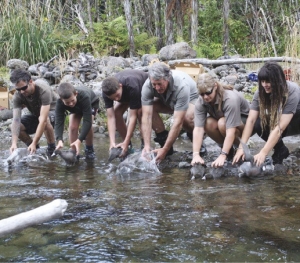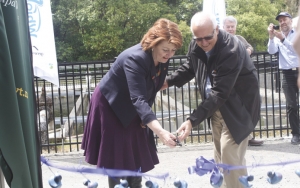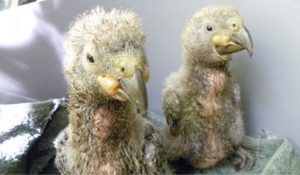Displaying items by tag: Whio
Whio release at Little Maketawa Stream
Captive Whio and new facility
Fabulous Whio
Whio released earlier this year
Lots of babies at Pukaha Mt Bruce
The Wairarapa breeding programme is going very well at Pukaha Mt Bruce. The Shore Plover programme has hatched 22 healthy chicks so far this year with five pairs now sitting on their third clutch.
The two pair of pateke are nesting again having so far successfully reared 12 ducklings between them.
The whio pair has three ducklings and there are three juvenile kiwi in the creche nearly ready for release as well as a kiwi chick hatched on Christmas Eve and one kiwi egg externally pipped and will hatch any day.
One red-crowned kakariki pair have three chicks to look after while another pair are waiting for their five eggs to hatch.
Wild kaka have this year utilised three of the nesting boxes with one pair already fledged and another three chicks not far behind.
Protecting our water birds
Whio News 2015
At Oparara/Ugly a 1080 drop in November 2014 was a success with rat numbers reduced from 58 before the drop to 0 after. Scott Freeman reported that summer was the best recorded at the site with 40 wild ducklings and five whione duckling released. Another 1080 drop was planned for this summer.
Kate Steffens reported from the Wangapka/ Fyfe site with very few floods and a dry summer they had the most productive whio season since monitoring began in 2003, with 36 fledgling from 16 pairs, and nine Whione juveniles were released from three clutches.
At the Te Urewera Whirinaki area they set up an entire site in one year instead of two. They installed 1600 double set DOC200s and needed volunteers to help with that. The heavy traps ranged between 16-24kg and had to be carried into the sites.
Tim Allerby reported the traps caught well. One block caught 26 stoats during one trap check.
Sara Treadgold reported a total of 22 confirmed whio paris were see within the Manganui o te Ao – Retaruke security site. This included 25 ducklings seen over the season.
Predator control saw 120 mustelids and 1372 rodents caught between July 2014-April 2015.
Tongariro Forest Security Site
Mild weather during spring along with a 1080 drop in August and a trap replacement programme saw a total 215 ducklings with 185 surviving to fledge.
A new trap line was installed on the Whakapapanui in Whakapapa Village run by Whakapapa residents. Interesting was the arrival of a whio of very pale colouring and paired up and set up territory on the Whakapapanui. (See Flight 162 p5.)
Egmont National Park Whio Recovery
The whio population at Egmont had a similar breeding success to the previous season and the census resulted in 86 whio being captured. Of these 31 were adult males, 31 were females and 17 were juveniles. (See Flight 163 p7.)
Egmont whio monitoring presents considerable effort with breeding across eight rivers within the National Park. From September 2014 to March 2015. A total of 32 pairs were located, an increase of two pairs on the previous season. A census was conducted with support and expertise of many whio practitioners and support from the Central North Island Blue Duck Trust. A total of 86 whio were captured though out the duration of the census.
Three adult birds caught were injured, two with head wounds consistent with injuries by stoats.
Captive breeding
Seventeen juveniles (including three females), were released into the Park. Ten whio including one female were released into the upper Waiwhakaiho River and seven including two females into the Little Maketawa Stream in February.
The trap network within Egmont National Park is serviced and maintained and since July 2014 trap catches were 245 stoats, 0 ferrets, 28 weasels, 16 cats and 1670 rats. Trap checks have continued for the 42 trap boxes on farmland.
Emily King
The 2014 season had been the best yet with 39 ducklings reared and 37 released back to the wild. These were from four pairs with Mt Bruce’s pair having three clutches and producing 16 young. A record for a pair in one breeding season. Peacock two pairs produced 18 and Orana Park pair produced five.
The big event for 2015 was the opening of the hardening facility at the Tongaririo Trout Hatchery which has turned out to be a great asset for getting captive juveniles ready for release.
Peter Russell
Breeding success continues at Mt Bruce Pukaha
Breeding success continues at Mt Bruce Pukaha
Shore Plover:
26 chicks were raised with some released at Waikawa and some at Motutapu. Four remain at Pukaha to continue with the breeding programme.
Pateke:
18 ducklings from the two breeding pairs at Pukaha. These were sent to the pre-release site, Peacock Springs near Christchurch, before they are released into the wild.
Whio:
2 male and 1 female ducklings hatched and reared by a pair at Pukaha have been sent to the pre-release site at Turangi. 13 ducklings were hatched from eggs collected from wild sites and of these 9 are male and 4 are females. They will remain at Mt Bruce Pukaha.
Whio freedom
A great day out at Ruatiti Domain on the Manganui a te Ao River where we released 12 captive reared Whio, 7 females and 5 males. We had a good turn out with school children, Iwi, Horizon councillors, land owners, two Orana Park staff who released one of the Whio they had raised, a film crew and Doc staff, interested visitors and Anne and me. The Whio were reared by staff at Peacock Springs, Orana Park and Mt Bruce.
Peter Russell.
Eds note: The Manganui a te Ao River starts on the western flank of Mt Ruapehu and flows westward through forest and steep hill country north-west of Raetihi, Waimarino County, Taihape and then joins the Wanganui River. The name means - stream; great; of; the; world.
Whio in the spotlight
With less than 3000 whio around New Zealand, they need all the help they can get.
A two-day Whio Recovery Workshop was held in June at Tokaanu, near Turangi, where people with a passion for the endangered nativeblue duck gathered to hear information, ask questions and get what answers they could, although the overwhelming conclusion was that there is still lots more to be done.
More than 50 people involved in whio protection in the North Island took part in the workshop, which was held at the Genesis Energy Tokaanu Power Station.
The attendees were able to grow and maintain links with like-minded people, share their skills, learn more about research and consider some of the innovations being tried to ensure the safety of whio and increase its numbers. That included new and better ways to keep predators away and, if possible, eliminate themwith best practice monitoring and trapping techniques.
The workshop group also visited the Turangi Trout Fishery, where they were shown how to set and use predator traps and how to set nets to catch ducks.
The recovery programme involves not only paid workers, but private organisations and volunteers. They give up their own time to set traps, walk trap lines every two to three weeks,and keep an eye on the ducks at the same time.
This workshop was not just a talkfest, but included the chance to learn about the latest research and tools, and take part in practical demonstrations such as trap maintenance and safety.
Threats to whio
Introduced predators are the whio’s worst enemies. A whio recovery plan includes trapping and the use of toxins to reduced predators. Without such work, there would be no whio.
Stoats are the main killers, along with ferrets, feral cats, falcons and dogs. But events such as floods, that scour out riverbanks, can take away the whio’s food source. Even resource consents, water use and discharge of dirty water are a threat. Then, for the females, their moulting phase makes them vunerable to predators, as they cannot fly away.
The recovery project, without which the whio would be gone, is expensive and a significant partner is a necessity. Genesis Energy has stepped in to provide funding - $2 million overfive years - and its staff have become involvedin helping with recovery projects.
In the early 1980s, the Moawhango Tunnel was commissioned in the upper Tongariro River and whio numbers decreased in that area because of the changed flow volumes of the river. By 2004, however, work was done to create a minimum flow and the population rebounded.
Predation remains the key risk
Around the country, both Government workers and volunteers continue to trap predators and take care of eggs. Floods can wipe out a whole season’s ducklings. There is also a need to increase gender diversity and the transfer of juveniles to other areas helps with this.
Recent use of DOC200 traps and double set traps (where two predators are caught in the same trap), along with aerial 1080 drops, have helped survival. David Rogerson reported setting 85 traps and catching 50 rats a fortnight along the Maramataha River in the King Country. Malcolm Swanney trained Fern, a German short-haired pointer dog, to become a champion whio finder who will never hurt a bird.
The Ruahine Ranges
Janet Wilson, a keen tramper from the Manawatu, started work as a DOC volunteer trapper in 2011 in the Ruahines.
The Ruahine Whio Protection Trust was formed as a collective and now a strong group of volunteers works along120 kilometres of the range. Many drive to Napier and work the Napier ridge to the Orva and back south. There are 1500 traps and it is steep terrain.
Wellington Tramping and Mountaineering Club volunteers drive to Hawke’s Bay once a month to check and manage traps from that side.
Janet said she was disappointed that not enough protection work was done by DOC. Along those ranges there were 60 huts, mostly old. There are 500 plus tracks, and lots of rivers. “We have seven groups working together as a collective and using DOC200 traps.”
Jessica Scrimgeour said Janet and the collective have worked hard to keep the system going. “Janet’s commitment has driven the plan over the years.”
Taranaki trial
A trial whio recovery plan was put in place during 1999-2000 in Taranaki to investigate a viable population. Fifteen birds were introduced, but, for a variety of reasons, did not survive. The group persevered with stoat control in 2002 and in 2008, they released 170 ducks, with a 50-50 gender balance.
Between 2011 and 2016, the number of pairs has been good with a survival rate of about 81 percent. The next phase is to increase gender diversity. Predator control remains essential, but it was also found that it is best to transfer juveniles and not adults to other areas.
Some New Zealand Deer Stalkers Association members have agreed to help out by checking traps while out hunting.
Tongariro
Rachel Abbot talked about the Kia Whariti biodiversity project, which also involves DOC and Genesis Energy, in the 20,000-hectare Tongariro forest, bordered by the Whakapapa, Whanganui and Mangatepopo rivers, where they are using DOC 200 traps plus double set traps, and aerial 1080 drops. Since 2007, trapping has been in progress with 700 traps along the trap line.
Future threats
Another possible threat to whio is plantation forestry logging. However, recent information suggests that forestry companies who are aware of the presence of ducks will move their operations away from any nesting sites until the chicks have left.
The Whio Workshop was a success, but there’s such a lot to do, so let’s hope it will lead to more protection for the lovely whio. Alison Beath, the convenor, a senior ranger with DOC, is to be congratulated on the event.
Cushy start for baby Whio
Playing mother duck comes naturally to Judy Fentress, the woman who can’t say no to an egg. Therefore it is not surprising she recently hatched three Whio ducklings – in an incubator. Well what did you think?
Judy has been in the hatching business for some time and in 2012 Flight ran a story about her and her passion for ducklings.
She thought we might be interested to know about the three Whio ducklings. Judy said she used the very same incubator, mentioned in the article in 2012. It was given to her by Hamilton DU members. In August this year she was given the Blue Duck eggs to hatch for the Otorohanga Kiwi House and Native Bird Park (Judy is an honorary life member after 15 years service as treasurer and helping with their wildlife breeding programme).
On September 8, these three little Whio ducklings hatched.
Some of us may remember the cheeky pukeko that became the star of the Genesis Power TV adds which were to help fund the protection of the Whio. Well Judy was the person who hatched that “cheeky pukeko”.
“Now I have hatched these three little Whio ducklings that will get to benefit from that very project.”
July was given another old incubator in 2013 from a DU member in Rangiwahia. “I cleaned it up, installed a digital thermometer, some egg racks and a few hatching baskets.
This incubator is now working perfectly and has been hatching all sorts of eggs over the past few years.”
During the egg laying season, Judy said she can have 3 to 4 large incubators going and full of various eggs.
“I incubate a lot of rescue eggs, where the nest or mother has been destroyed, or left the nest. If the eggs get into my incubators soon enough, there is a very good chance they will survive. I hatch a lot of rescue mallard eggs (60 so far this year) from Fish & Game as well as individuals finding eggs in need of help.”
Well done Judy, and long may you keep up the good work for some time come.





